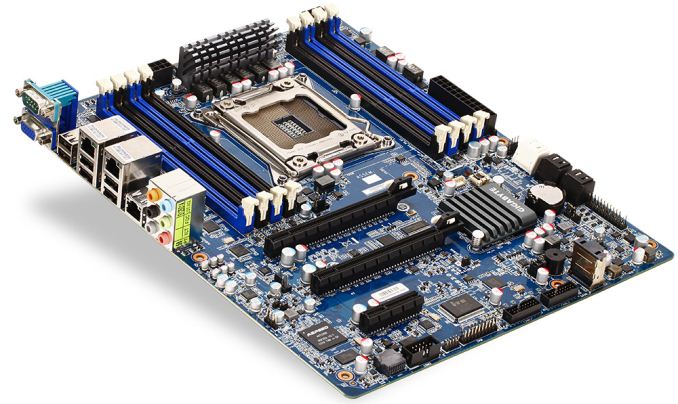GIGABYTE GA-6PXSV3 Review
by Ian Cutress on March 31, 2014 11:59 AM EST- Posted in
- Motherboards
- Gigabyte
- SLI
- CrossFire
- X79
- Enterprise
- C604
GIGABYTE GA-6PXSV3 Conclusion
Server motherboards can be difficult to judge. Prices are almost always set around the business customer needs, and for consumers they can feel overly expensive for the standard features they provide. However end-users have to go down this route if they need a full server motherboard experience, either for a workstation or HPC type environment (under the desk) that needs ECC or management features. There are some consumer motherboards that will cater vaguely to ECC UDIMM memory, or Xeon compatibility, but management is solely in the server/workstation motherboard segment.
So when it comes down to the GIGABYTE GA-6PXSV3, we have that enhanced control when the machine is not in use (or from a remote location), but the software, compared to the consumer level brethren, is almost zero. This comes back to the argument of a large company separating its consumer and business facing motherboard production teams. Incidentally, the GIGABYTE BRIX is made by the server team and distributed to e-tailers via the consumer side of the company, so there is potential for cross-over.
Having a dual Intel NIC and management interface is a plus, along with the audio which is present due to the workstation orientation of the layout. The PCIe layout is different, with the GA-6PXSV3 only using 32 PCIe 3.0 lanes from the CPU rather than all 40, essentially meaning that the lanes you pay for on the CPU are wasted. In order to account for the extra controllers (Etron USB 3.0, NICs, AST2300), the PCIe x4 lane at the bottom runs at PCIe 2.0 x2 in order to have enough lanes for everything else. The two USB 3.0 headers is a plus, especially for chassis that have two USB 3.0 connectors. The C604 chipset also opens up a mini-SAS port for four SAS 3 Gbps drives, however we do not have an internal USB port on the motherboard like some other server motherboards we have reviewed in the past.
Performance from the GA-6PXSV3 with the Core i7-4960X compared to the other socket 2011 motherboards we have tested was underwhelming. In almost every benchmark it suffers a small deficit to the MSI X79A-GD45 Plus for two main reasons. Firstly is the memory – the GA-6PXSV3 does not allow users to apply XMP or adjust memory subtimings. While we were able to put our kit to DDR3-1866 to match the MSI, we had a CAS latency deficit (CAS 8 on the MSI, CAS 12 on the GIGABYTE). The second reason comes from stability. Consumer motherboards are often designed to implement turbo modes earlier and longer, whereas server motherboards will (or should) adhere strictly to Intel specifications and as a result might lose a turbo bin earlier in the computational cycle and performance may suffer. One change GIGABYTE could make is to the default processor performance option in the BIOS CPU Power Management menu, changing it from balanced performance to high performance and taking the small hit in power consumption.
The GIGABYTE GA-6PXSV3 settled well in our single GPU gaming tests, but missed a beat in our dual GPU testing. GIGABYTE is still investigating why my shutdown issue occurs with two GPUs and they cannot reproduce it. The GIGABYTE BIOS may not be UEFI, but for server usage it has so many settings it is well advised to sit beside it with the manual in hand.
Server motherboards are not designed to be looked at, not designed to love you and are never designed to make you feel good by showing it off at a LAN party. They are designed to remain switched on and offer stability with external management options. While it is relatively impossible to test stability in the normal review timeframe (even in a heatbox), the GIGABYTE GA-6PXSV3 offers a relatively rare combination of RDIMM and ECC compatibility with Crossfire/SLI, USB 3.0, mini-SAS, dual Intel NICs, management options and DDR3-1866 MHz support under that banner of stability. A recommendation for GIGABYTE is that this motherboard needs an extra element of BIOS and software configuration, as well as more aggressive processor frequency policy and needs to use all 40 PCIe lanes from the CPU with more PCIe slots.











12 Comments
View All Comments
Navvie - Thursday, April 3, 2014 - link
People buy motherboards based on how they look? Sheesh, I'm getting old.superunknown98 - Thursday, April 3, 2014 - link
I unfortunately just found out the 82574L nic is not supported by intel in server 2012 r2. Microsoft drivers only.